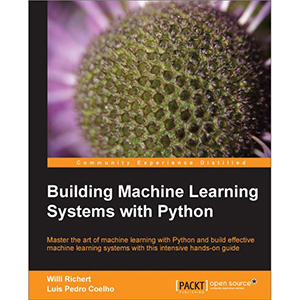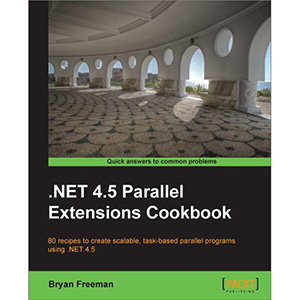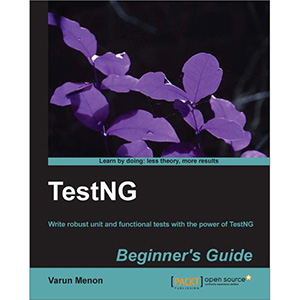Wow! eBook: Building Machine Learning Systems with Python - 5 new eBooks |  |
- Building Machine Learning Systems with Python
- .NET 4.5 Parallel Extensions Cookbook
- TestNG: Beginner’s Guide
- Vaadin 7 UI Design By Example: Beginner’s Guide
- vSphere High Performance Cookbook
| Building Machine Learning Systems with Python Posted: 25 Nov 2013 04:38 AM PST
Book DescriptionMachine learning, the field of building systems that learn from data, is exploding on the Web and elsewhere. Python is a wonderful language in which to develop machine learning applications. As a dynamic language, it allows for fast exploration and experimentation and an increasing number of machine learning libraries are developed for Python. Building Machine Learning system with Python shows you exactly how to find patterns through raw data. The book starts by brushing up on your Python ML knowledge and introducing libraries, and then moves on to more serious projects on datasets, Modelling, Recommendations, improving recommendations through examples and sailing through sound and image processing in detail. Using open-source tools and libraries, readers will learn how to apply methods to text, images, and sounds. You will also learn how to evaluate, compare, and choose machine learning techniques Written for Python programmers, Building Machine Learning Systems with Python teaches you how to use open-source libraries to solve real problems with machine learning. The book is based on real-world examples that the user can build on. Readers will learn how to write programs that classify the quality of StackOverflow answers or whether a music file is Jazz or Metal. They will learn regression, which is demonstrated on how to recommend movies to users. Advanced topics such as topic modeling (finding a text's most important topics), basket analysis, and cloud computing are covered as well as many other interesting aspects. Building Machine Learning Systems with Python will give you the tools and understanding required to build your own systems, which are tailored to solve your problems. What you will learn from this book
Approach Who this book is for This book primarily targets Python developers who want to learn and build machine learning in their projects, or who want to provide machine learning support to their existing projects, and see them getting implemented effectively. Book Details
Related Books
The post Building Machine Learning Systems with Python appeared first on Wow! eBook. |
| .NET 4.5 Parallel Extensions Cookbook Posted: 25 Nov 2013 04:33 AM PST
Book Description.NET parallel extensions brings the power of parallel and asynchronous programming to a much wider developer audience than ever before. This book will give a developer with no multithreaded development experience the ability to write highly scalable parallel applications that take advantage of modern multicore processors.If you are an experienced .NET developer who wants to put parallel extensions to work in your applications, this book is for you. “.NET 4.5 Parallel Extensions” is a practical, hands-on guide that provides you with a number of clear step-by-step recipes that will introduce parallelism into your applications and take advantage of modern multicore processors. This book is a crash course in using the extensions, with theory and concepts kept to a minimum. “.NET 4.5 Parallel Extensions” offers a wide-ranging presentation of parallel development concepts, and provides a working knowledge of key technologies that are important to developers who want to take advantage of multi-core architectures. You will learn how to compose a series of producer/consumer tasks into a pipeline that can process data elements received from a real-time event stream. You will also learn how to connect the stages of pipelines together using the concurrent collections. You will learn everything you need to know to transform the multicore power found in modern processors into application performance and scalability. What you will learn from this book
Approach Who this book is written for Book Details
Related Books
The post .NET 4.5 Parallel Extensions Cookbook appeared first on Wow! eBook. |
| Posted: 25 Nov 2013 04:31 AM PST
Book DescriptionUnit/Functional testing has now become part of every development life cycle. Junit was once the main framework that was used by developers for the purpose of Unit testing when it came to Java. But Junit had certain limitations in terms of execution and features. This book explains about the features and usage of TestNg, a new framework that overcomes Junit's limitations and provides a lot of extra features. TestNg Beginner's Guide is a practical, hands-on guide that aims to increase your knowledge of TestNg. This step-by-step guide will help you to learn and understand the different TestNg features, and you will learn about the advantages and how to use and configure each feature according to your needs. This book explains the various features of the TestNG testing framework. It provides a step-by-step guide that explains the different features with practical examples and sample programs.You will also learn about how to use and configure each feature based on different test scenarios. We will also take a look at extending TestNG to add custom logging and test-reports. If you are a beginner in TestNG or test frameworks, then this book will help you in learning, practising, and getting started with TestNg. What you will learn from this book
Approach Who this book is written for Book Details
Related Books
The post TestNG: Beginner’s Guide appeared first on Wow! eBook. |
| Vaadin 7 UI Design By Example: Beginner’s Guide Posted: 25 Nov 2013 04:26 AM PST
Book DescriptionVaadin is a mature, open-source, and powerful Java framework used to build modern web applications in plain Java. Vaadin brings back the fun of programming UI interfaces to the web universe. No HTML, no CSS, no JavaScript, no XML. Vaadin lets you implement web user interfaces using an object oriented model, similar to desktop technologies such as Swing and AWT. Vaadin 7 UI Design By Example: Beginner's Guide is an engaging guide that will teach you how to develop web applications in minutes. With this book, you will Develop useful applications and learn basics of Java web development. By the end of the book you will be able to build Java web applications that look fantastic. The book begins with simple examples using the most common Vaadin UI components and quickly move towards more complex applications as components are introduced chapter-by-chapter. Vaadin 7 UI Design By Example: Beginner's Guide shows you how to use Eclipse, Netbeans, and Maven to create Vaadin projects. It then demonstrates how to use labels, text fields, buttons, and other input components. Once you get a grasp of the basic usage of Vaadin, the book explains Vaadin theory to prepare you for the rest of the trip that will enhance your knowledge of Vaadin UI components and customization techniques. What you will learn from this book
Approach Who this book is written for Book Details
Related Books
The post Vaadin 7 UI Design By Example: Beginner’s Guide appeared first on Wow! eBook. |
| vSphere High Performance Cookbook Posted: 25 Nov 2013 04:23 AM PST
Book DescriptionVMware vSphere is the key virtualization technology in today's market. vSphere is a complex tool and incorrect design and deployment can create performance-related problems. vSphere High Performance Cookbook is focused on solving those problems as well as providing best practices and performance-enhancing techniques. vSphere High Performance Cookbook offers a comprehensive understanding of the different components of vSphere and the interaction of these components with the physical layer which includes the CPU, memory, network, and storage. If you want to improve or troubleshoot vSphere performance then this book is for you! vSphere High Performance Cookbook will teach you how to tune and grow a VMware vSphere 5 infrastructure. This book focuses on tuning, optimizing, and scaling the infrastructure using the vSphere Client graphical user interface. This book will enable the reader with the knowledge, skills, and abilities to build and run a high-performing VMware vSphere virtual infrastructure. You will learn how to configure and manage ESXi CPU, memory, networking, and storage for sophisticated, enterprise-scale environments. You will also learn how to manage changes to the vSphere environment and optimize the performance of all vSphere components. This book also focuses on high value and often overlooked performance-related topics such as NUMA Aware CPU Scheduler, VMM Scheduler, Core Sharing, the Virtual Memory Reclamation technique, Checksum offloading, VM DirectPath I/O, queuing on storage array, command queuing, vCenter Server design, and virtual machine and application tuning. By the end of this book you will be able to identify, diagnose, and troubleshoot operational faults and critical performance issues in vSphere. What you will learn from this book
Approach Who this book is for Book Details
Related Books
The post vSphere High Performance Cookbook appeared first on Wow! eBook. |
| You are subscribed to email updates from Wow! eBook To stop receiving these emails, you may unsubscribe now. | Email delivery powered by Google |
| Google Inc., 20 West Kinzie, Chicago IL USA 60610 | |





Tidak ada komentar:
Posting Komentar